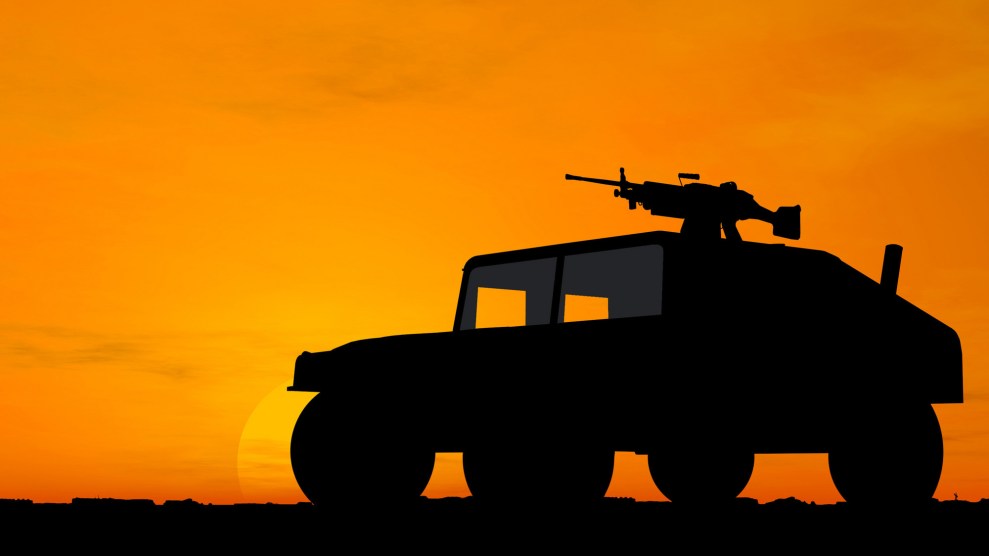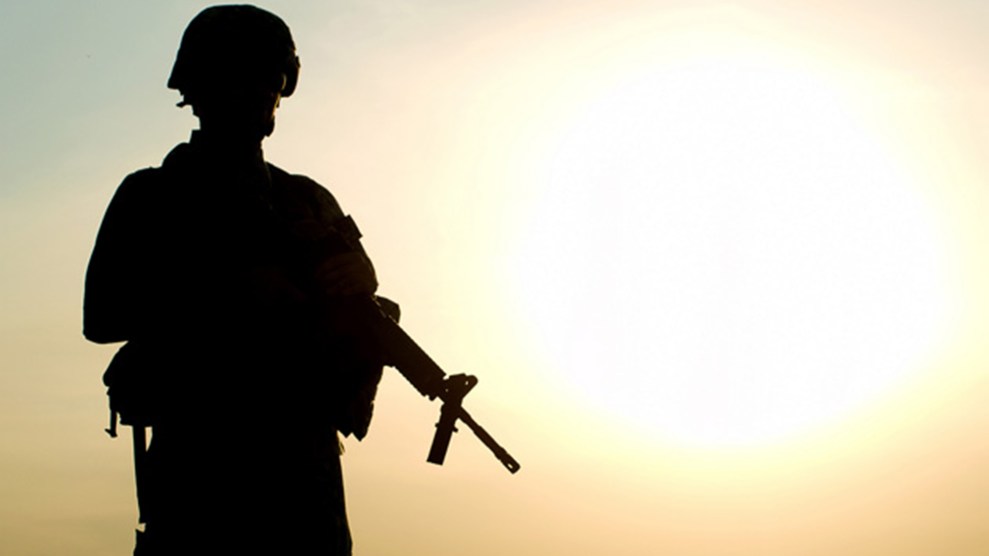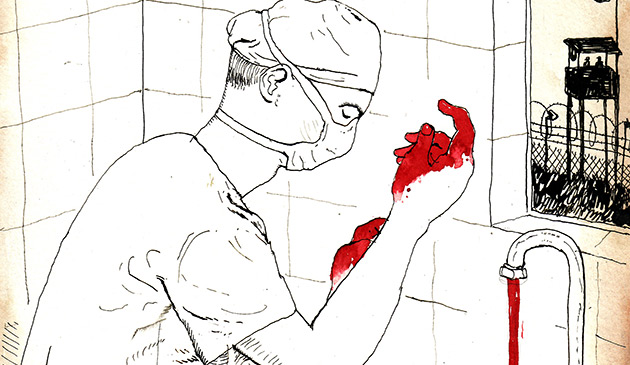
<a href="http://www.shutterstock.com/pic-2850353/stock-photo-silhouette-of-truck-over-sunset.html?src=OuQItiSuT61FzLEft1oIKg-1-4">TebNad</a>/Shutterstock
This story first appeared on the TomDispatch website.
Memorial Day is over. You had your barbeque. Now, you can stop thinking about America’s wars and the casualties from them for another year. As for me, I only wish it were so.
It’s been Memorial Day for me ever since I first met Tomas Young. And in truth, it should have felt that way from the moment I hunkered down in Somalia in 1993 and the firing began. After all, we’ve been at war across the Greater Middle East ever since. But somehow it was Tomas who, in 2013, first brought my own experience in the US military home to me in ways I hadn’t been able to do on my own.
That gravely wounded, living, breathing casualty of our second war in Iraq who wouldn’t let go of life or stop thinking and critiquing America’s never-ending warscape brought me so much closer to myself, so bear with me for a moment while I return to Mogadishu, the Somalian capital, and bring you—and me—closer to him.
In that spring of 1993, I was a 22-year-old Army sergeant, newly married, and had just been dropped into a famine-ridden, war-torn Third World country on the other side of the planet, a place I hadn’t previously given a thought. I didn’t know what hit me. I couldn’t begin to take it in. That first day I remember sitting on my cot with a wet t-shirt draped over my head, chugging a bottle of water to counter the oppressive heat.
I’d trained for this—a real mission—for more than five years. I was a Black Hawk helicopter crew chief. Still, I had no idea what I was in for.
So much happened in Somalia in that “Black Hawk Down” year that foreshadowed America’s fruitless wars of the twenty-first century across the Greater Middle East and parts of Africa, but you wouldn’t have known it by me. That first day, sitting in a tent on the old Somali Air Force base in Baledogle, a couple of hours inland from the capital city of Mogadishu, I had a face-to-face encounter with a poisonous black mamba snake. Somehow it didn’t register. Not really.
This is real, I kept telling myself in the six months I spent there, but in a way it wasn’t or didn’t seem to be.
After about a month, my unit moved to the airport in Mogadishu—away from the snakes, scorpions, and bugs that infested Baledogle, but closer to dangers of a more human sort. Within a few weeks, I became used to the nightly rat-tat-tat of machine gun fire coming at us from the city. I watched the tracers streak by as we crouched behind our sandbagged fighting positions. We would return from missions to find bullet holes in the skin or rotor blades of our Black Hawk helicopters, or in one case a beer-can-sized hole that a rocket-propelled grenade (RPG) round punched cleanly through the rear stabilizer without—mercifully—detonating.
And yet none of it felt like it was quite happening to me. I remember lying on my cot late at night, not far from the flight line full of Black Hawks and Cobras, hearing the drone of low-flying American AC-130 gunships firing overhead for hours on end. The first boom would come from the seaward side of the field as the gunship fired its M102 howitzer. A few seconds later, another boom would mark the round’s arrival at its target across town, sometimes with secondary explosions as ammunition stores went up. Lying there, I remember thinking that those weren’t the routine training rounds I’d heard a hundred times as they hit some random target in a desolate training area. They were landing on real targets, actual people.
Two other memorable booms come to mind—one as we waited in the back of a sun-baked supply truck, heading out on a volunteer mission to give inoculations to kids at a Somali orphanage. Boom. The ground shook to the sound of one of our Humvees and the four Army soldiers in it being blown apart by the sort of remote-controlled bomb that would become a commonplace of insurgents in America’s twenty-first century wars. And a second, the loudest during my six months there, as a generator perhaps 20 feet from our tent exploded into flames from an incoming RPG round that found its target in the middle of the night.
This is real. I kept saying that to myself, but truthfully the more accurate word would have been surreal. The care packages I was receiving, the Tootsie Rolls and Cracker Jacks and letters from my wife back home telling me how much she missed me might as well have been from another planet.
Our helicopters flew daily reconnaissance missions (“Eyes over Mog” we called them) above the Somali capital. We did battle damage assessments, checking out pockmarked buildings the AC-130s had targeted the night before, or the shot-up safe house that Somali warlord Mohamed Aidid—our operation’s target (just as the US would target Saddam Hussein, Moammar Gadhafi, and the leaders of various terror groups)—had reportedly been using as a control center. Once a beautiful mansion, it was now riddled with thousands of bullet holes and TOW missile craters.
We flew over Mogadishu’s bustling marketplace, sometimes so low that the corrugated metal roofs of the stalls would blow off from our rotor wash. We were always looking for what we called “technicals”—pick-up trucks with machine guns mounted in their beds—to take out. Viewing that crowded marketplace through the sight of a ready-to-rock M-60 machine gun helped reinforce the message that all of this was beyond surreal.
Lives were ending violently here every day, and my own life, too, could have ended at any moment. Yet it was just about impossible to believe that all of a sudden I was in the middle of a violent set of incidents in a Third World hellhole, the sort of thing you might read about in the paper, or more likely, would never hear about at all. You’d never know about our near-nightly scrambles to our fighting positions behind a pile of sandbags, as the AK-47s cracked and the tracers flew overhead. It wouldn’t even register as a blip in the news back home. In some bizarre way, I was there and it still wasn’t registering.
Just days after returning home from Somalia, I (like so many others) watched the footage of dead American soldiers—at least one a Black Hawk crew chief—being dragged through the streets of Mogadishu by cheering Somalis. For the first time, I found myself filled with a sense of dread, a profound that-could-have-been-me feeling. I imagined my mother looking at such a photo of me, of her dead son’s body—as someone’s mother was undoubtedly doing.
If my interior landscape was beginning to shift in unsettling ways, if the war, my war, was finally starting to come home, I remained only minimally aware of it. My wife and I started a family, I got a civilian job, went to college in the evening using the GI Bill, and wrote a couple of books about music—my refuge.
Still, after Somalia, I found myself drawn to stories about war. I reread Stephen Ambrose’s blow-by-blow account of the D-Day landings, picked up Ron Kovic’s Vietnam memoir, Born On The Fourth Of July, for the first time, and even read All Quiet On The Western Front. And all of them somehow floored me. But it wasn’t until I watched Body of War, Phil Donahue’s 2008 documentary about Iraq war veteran and antiwar activist Tomas Young, that something seemed truly different, that I simply couldn’t shake the feeling it could have been me.
Tomas was a kid who had limited options—just like me. He signed up for the military, at least in part, because he wanted to go to college—just like me. Yes, just like so many other kids, too—but above all, just like me.
He, too, was deployed to one of America’s misbegotten wars in a later hellhole, and that’s where our stories began to differ. Five days after his unit arrived in Iraq—a place he deployed to grudgingly, never understanding why he was being sent there and not Afghanistan—Tomas was shot, his spinal cord severed, and most of his body paralyzed. When he came home at age 24, he fought the natural urge to suffer in silence and instead spoke out against the war in Iraq. Body of War chronicled his first full year of very partial recovery and the blossoming of his antiwar activism.
Just a few weeks after the film’s release, however, it all came crashing down. He suffered a pulmonary embolism and sank into a coma, awakening to find that he’d suffered a brain injury and lost much of the use of his hands and his ability to speak clearly. The ensuing years were filled with pain and debilitating health setbacks. By early 2013, he was in hospice care, suffering excruciating abdominal pain, without his colon, and on a feeding tube and a pain pump. Gaunt, withered, exhausted, he continued to agitate against America’s never-ending war on terror from his bed, and finally wrote a “last letter” to former President George W. Bush and former Vice President Dick Cheney, airing his grievances, which got significant media attention.
When I read it, I felt that he might have been me if I hadn’t lucked out in Mogadishu two decades earlier. Maybe that’s what made me reach out to him that April and tell him I wanted to learn more about what had happened to him in the years between Body of War and his last letter, about what it meant to go from being an antiwar agitator in a manual wheelchair to a bedridden quadriplegic on a feeding tube and under hospice care, planning to soon end his own life.
When I finally met Tomas, I realized how much he and I had in common: the same taste in music and books, the same urge to be a writer. We were both quick with the smart-ass comment and never made to be model soldiers because we liked to question things.
Each moment we spent together only connected us more deeply and brought me closer to the self that war had created in me, the self I had kept at such a distance all these years. I began writing his story because I felt compelled to show other Americans someone no different from them who had had his life, his reality, upended by one of our military adventures abroad, by deployment to a country so distant that it’s an abstraction to most of us who, in these days of the all-volunteer Army, don’t have a personal connection either to the US military or to the wars it so regularly fights.
A historically low percentage of our population—less than half a percent—actually serves in the military. Compare that to around 9 percent during the Vietnam War, and 12 percent during World War II. Remarkably few of us ever see combat, ever even know anyone who was in combat, ever get to hear firsthand stories of what went on or witness what life is like for such a returning veteran. Not surprisingly, America’s wars now largely go on without us. There is no personal connection. Here in “the homeland”—despite the overblown fears of “terrorism”—it remains “peacetime.” As a consequence, few of us are engaged by veterans’ issues or the prospect—essentially, the guarantee—of more war in the American future.
Tomas understood the importance of sharing the brutal fullness of his story. For him, there were to be no pulled punches. When I told him I wanted others to learn of his harrowing tale, of his version of the human cost of war, that I wanted to help him to tell that story, he responded that he had indeed wanted to write his own book. He’d scrapped the project because he could no longer write, and even Dragon voice-to-text software wouldn’t work because his speech had become so degraded after the embolism struck.
Instead, he shared everything. Tomas and his wife, Claudia, opened their lives to me. I slept in their basement. During my periodic visits, he introduced me to an expansive mind in a shrunken world, a mind that wanted to range widely in a body mostly confined to a hospital bed, surrounded by books, magazines, and an array of tubing that delivered medications and removed bodily wastes in a darkened bedroom.
“I need to be fed,” he said to me one day. “Do you want to see what that’s like?” Then, he lifted his shirt and showed me the maze of tubing and scars on his body. It was a map of the ravages of war.
He was unflinchingly honest, sensing the importance of his story in a country where such experiences have become uncommon fare. Like his comic book heroes Batman and the Punisher, he wanted to make sure that no one would have to endure what he’d gone through.
Tomas Young’s war ended on the night before Veterans’ Day 2014 when he passed away quietly in his sleep. His pain finally came to an end.
The bullets that hit him in the streets of Baghdad in 2004 brought on more than a decade of agony and hardship, not only for him, but for his mother, his siblings, and his wife. Their suffering has yet to end.
Stories of the reality of war and its impact on this country are more crucial now than ever as America’s wars seem only to multiply. Among us are more than 2.5 million veterans of our recent conflicts in Iraq and Afghanistan. We owe it to them to read their accounts—and an increasing number of them are out there—and do our best to understand what they’ve been through, and what they continue to go through. Then perhaps we can use that knowledge not only to properly address their needs, but to properly debate and possibly—like Tomas Young—even protest America’s ongoing wars.
It would have been perfectly understandable for Tomas to have faced the pain, frustration, and failing health of his final years privately and in silence, but that wasn’t him. Instead, he made his story part of our American record.
Mark Wilkerson spent eight years in the U.S. Army as an AH-1 Cobra and UH-60 Black Hawk helicopter crew chief with the 3rd Infantry and 101st Airborne Divisions. He was deployed with the 101st to Somalia for six months in 1993. He is the author of Who Are You: The Life of Pete Townshend and co-wrote Pearl Jam Twenty. He has three children: Alex, Nick, and Sam. He lives in Louisville, Kentucky, with his wife, Melissa. His latest book is Tomas Young’s War (Haymarket Books).
Copyright 2016 Mark Wilkerson
















